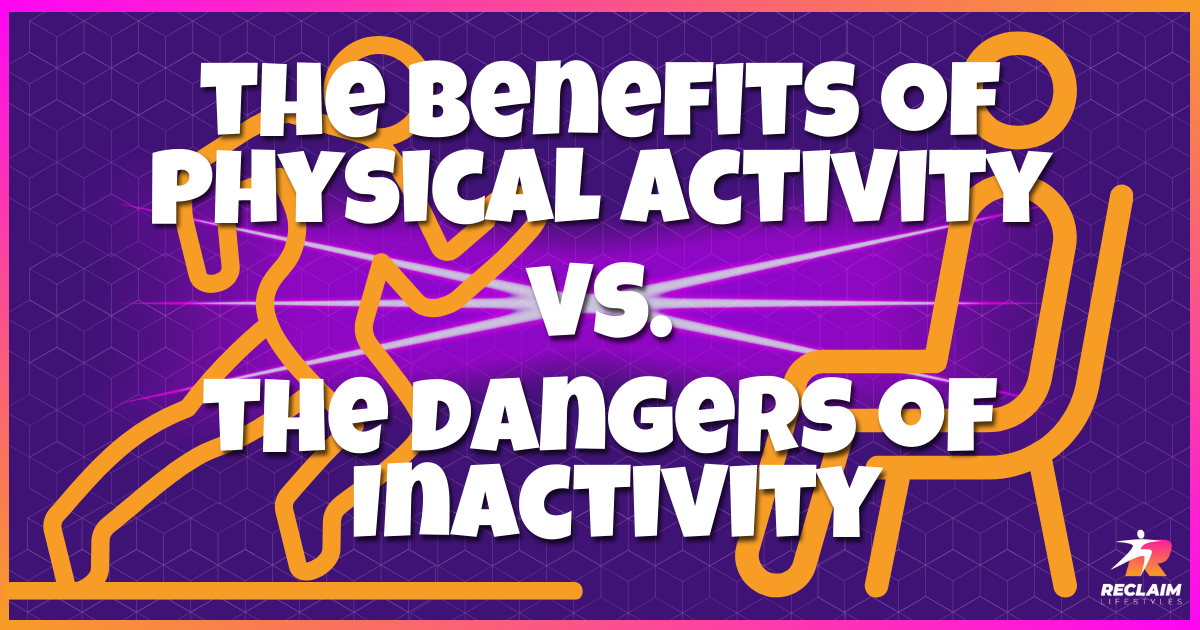The Benefits of Physical Activity vs. the Dangers of Inactivity for Older Adults
Although physical fitness is important throughout our lives, it tends to be when we’re getting “up there” that we start to really feel the cumulative effects of however we’ve been taking care of ourselves up to that point. New body parts start aching, you reach for something and realize you can’t bend the same ways you used to, or your doctor prescribes you medication to bring down your blood pressure. There are lots of ways our bodies can manifest little alarms to try to get our attention when things are in a state of… let’s say “disrepair.”
Just like you would perform routine maintenance and upkeep on an investment property, or make regular deposits into your retirement account, making investments in your health throughout your lifetime can make a big difference for how you get to enjoy your later years. And so it goes in the reverse: if you leave that rental alone for too long, it’ll start to look like a dump and be harder to rent out at the same rate; if you never put money into a retirement account, you’ve got a lot more work ahead of you; and if you don’t take care of your physical fitness while you still can, whatever you’re not using, prepare to lose it.
The Four Horsemen of Poor Health for Aging Adults
There are four main things that are most likely to impact our health as we age:
- Type 2 diabetes
- Atherosclerosis
- Cancer
- Dementia
So how can you avoid all these “bad guys?” What if we told you there’s a magic pill that can drastically reduce your risk of developing all four of these conditions? Don’t believe us? Well, okay, it’s not actually a pill. But if it were a drug, it’d be the most prescribed medication in the world: Exercise. (If you didn’t see that one coming, then we invite you to peruse our past blog posts to get acquainted with our M.O. here.)
Exercise offers a huge array of benefits for every human’s health, but in the context of healthy aging, it’s a key tool for improving not only your lifespan but your healthspan—the amount of time you live healthily and able to do all the things you want to keep doing.
And conversely, not exercising has some pretty steep penalties (see: the aforementioned Four Horsemen).
So how does physical activity support your health? Let’s break down some of the benefits of getting and staying active as we age in particular.
Muscle Mass
After about the age of 30, we begin losing muscle mass at a fairly steady rate. But muscle mass is correlated with some major health outcomes, including risk of mortality. Yeah, your risk of death by any cause goes up as your muscle mass goes down. Plus, sarcopenia (the technical term for loss of muscle mass) affects your mobility, which might have gone without saying, except that it’s worth keeping in mind when considering how long you’d like to live independently in your later years. If you lose the ability to carry out the tasks of daily living, like getting up out of bed, transferring yourself to the bathroom, putting on your clothes, etc., you’re going to find yourself in assisted living perhaps sooner than you’d like.
Maintaining your muscle mass with regular exercise can go a long way toward keeping you alive–and kicking!–for longer. Curious where your muscle mass is at? Grip strength is a commonly used indicator of overall health because it’s pretty easy to measure. So if you’re having more trouble with pickle jars these days, maybe it’s time to pick up some weights.
Cardiovascular Health
Your Resting Heart Rate (RHR) is a commonly used measurement for physical fitness. A lower RHR usually implies better cardiovascular fitness because your heart is more efficient at pumping more blood with less beats. So how do you make your heart more efficient? You make it work to get stronger with aerobic exercise! Physical activity is a recognized preventive measure for atherosclerosis, or the buildup of plaques in your arteries, which can lead to medical events like heart attacks, strokes, clots, or aneurysms.
Working out your heart with aerobic exercises can be as simple as going for a nice walk. Zone 2 training, or training at a level of intensity at which you can still carry on a conversation while you’re doing it, is effective at burning fat and improving heart health. So go for a stroll with a friend and give your heart and your mood a boost!
Disease Prevention
Beyond reducing your risk of the Four Horsemen, physical activity can reduce your risk of developing other diseases, like Parkinson’s disease. Because Parkinson’s is a neurodegenerative disorder that affects the dopamine-producing neurons in part of the brain, aerobic exercise can help patients manage their symptoms by increasing dopamine levels. And high-intensity training, like cycling, has been shown to not only slow disease progression but also may help improve the health and function of remaining dopaminergic neurons.
Neuroprotective and Cellular Effects
Speaking of neurons, exercise promotes overall neurological and cellular health. Studies show that an active lifestyle can help with numerous age-related changes in the brain, including slowing the decline in adult neurogenesis, which is the process of creating new neurons. Physical activity also helps protect brain health as we age by supporting the blood-brain barrier, enhancing plasticity, helping the brain clear waste, and more.
As for cellular health, remember the mitochondria? “The powerhouse of the cell?” Mitochondria regulate critical cellular processes and are key to maintaining organ and tissue health. Studies have shown that exercise stimulates mitochondrial turnover, which improves their quality and function.
The Dangers of Inactivity
If a bloodthirsty beast were chasing you down, you’d be pretty motivated to get moving away from it, right? But when there’s nothing chasing you, what’s supposed to motivate you to get away from some unseen risk? It may not have fangs and claws, but inactivity is just as deadly as a hungry tiger. And understanding just how dangerous it is to do nothing can help motivate positive lifestyle changes.
Chronic Disease Risk
Inactivity is linked to increased risk of most chronic diseases, including, you guessed it, the Four Horsemen of type 2 diabetes, cancer, atherosclerosis, and dementia. But beyond those four are another 30+ conditions that are all pretty unpleasant (check out the full list in this article abstract). Yikes.
Functional Decline
As you might have guessed, losing muscle mass can make it more difficult to move your body around and manipulate your environment. As daily tasks get harder, quality of life can take a nosedive. And increased frailty increases your fall risk and limits your independence, especially if you fall and can’t get up. The old “use it or lose it” adage is apt here. If you don’t keep doing stairs, you’ll lose the ability to do them.
Move Like Your Life Depends on It
If you’ve slipped into a bit of a sedentary lifestyle over the years, you’re not alone. Data from a study by researchers at the World Health Organization shows that 31% of adults worldwide were not meeting the recommended levels of physical activity in 2022, which is up 5 points from 2010. If we keep up with that trend, levels of inactivity will rise to 35% by 2030. That doesn’t bode well for global health in the next few decades. But at Reclaim Lifestyles, we believe that anyone can make a positive difference for their health by taking small steps forward on a consistent basis. And we believe that committing to making these changes is worth it. Whether we’ve witnessed loved ones struggle with poor health at the end of their lives, or experienced our own health diagnoses that have been a wake-up call, we are passionate about helping people live better, longer lives with regular physical activity.
So maybe this blog post isn’t a snarling lion, but hopefully having a little more information about the science behind the benefits of physical activity and the dangers of inactivity can be a little boost of motivation for getting a little more movement today. So move like your life depends on it! (In small, sustainable ways!) Because it does.



